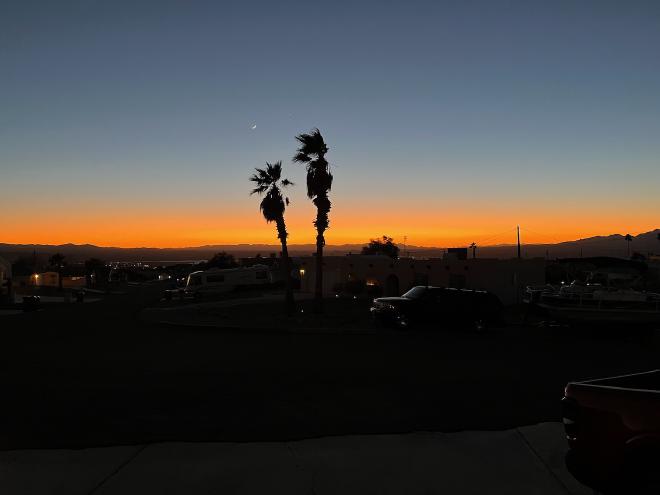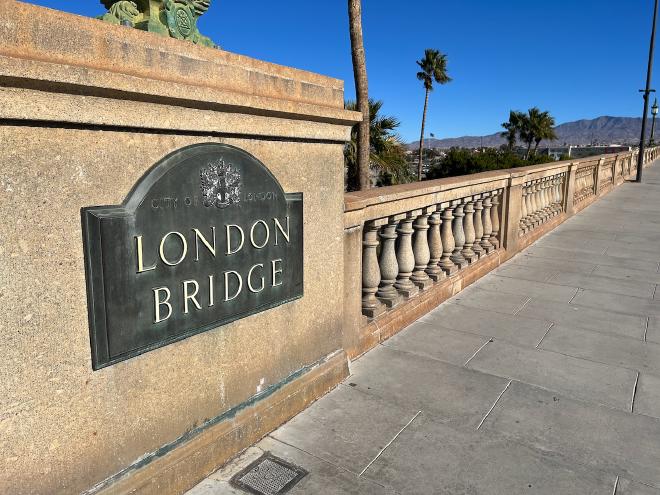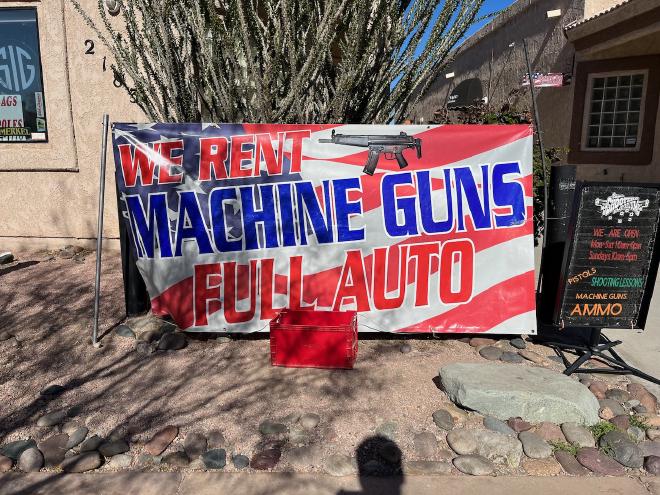Mojave plan

In the early 1980s, Tangerine Dream made a major change to their sound. While 1980’s “Tangram” is warm and reassuring throughout, 1981’s “Exit” echoed the nuclear paranoia of the time. In 1982, they continued the theme with “White Eagle”, which opens with a chilly alien soundscape, the beginning of a piece called “Mojave Plan”. Ever since I first heard it, I had wanted to visit the Mojave desert.
Decades on, I found myself driving through the Mojave desert, reflecting on just how good a soundtrack they made. At first, there’s emptiness — flat sand, occasional dust trails, sometimes an RV or caravan parked in the middle of absolute nowhere, presumably occupied by someone who has had it with modern civilization. Then there’s a railroad crossing, and a goods train rattling its way across the desert. Later, you speed past odd miniature industrial parks, largely unsignposted. Finally, you near the chaotic sprawl of a city, its rhythms out of place, an entire artificial environment imposed at great cost in an unwelcoming landscape.
From 1934 to 1938, a dam was constructed in the desert, downstream from the Hoover Dam, on the border of California and Arizona. The result was a reservoir, now known as Lake Havasu, which provides most of the water to Los Angeles, San Bernadino, San Diego, Phoenix and Tucson. The land occupied by the lake had previously belonged to the Chemehuevi Indian tribe, who were understandably not pleased that their land had been stolen and their agriculture destroyed. After a 1951 lawsuit, they obtained $900,000 in compensation from the federal government.
Then, in 1958, millionaire industrialist Robert McCulloch purchased 13 square kilometers of desert land on the Arizona side of the lake; he bought another 52 square kilometers four years later. He partnered with C.V. Wood, the master planner of Disneyland, to design and build his dream of a planned city.
McCulloch wanted his city to have a centerpiece, and tasked his realtor with finding one. In 1968, the City of London decided it needed to demolish the New London Bridge and build an even newer London Bridge that could take the weight of motor vehicles. McCulloch was persuaded to purchase the old bridge for nearly $2.5m. The bridge was disassembled brick by brick, all the visible bricks were carefully numbered, and then they were shipped to the middle of the Arizona desert.
The urban legend is that McCulloch thought he was buying Tower Bridge, but this is extremely unlikely. The disassembly and reassembly involved extremely detailed diagrams showing the position of every brick, and the destination site had to be prepared ahead of time based on the diagrams. Also, McCulloch took some persuading by his realtor, and it seems unlikely that the realtor would commit outright fraud and still be working with him years later.
Once the bridge had been built in the right place, channels were dug under it and flooded to expand the lake to underneath it. The reconstructed bridge has the original bricks over a modern concrete core, which means it can take the weight of modern vehicles, so you can drive on it as well as walk across it. The pedestrian pavement isn’t genuine London Borough Council compressed concrete paving slabs, but it has the right size rectangles and looks authentic enough that I found it to be the most oddly convincing detail. This made me realize for the first time that pavement in England is a lot more standardized than in the US, where basically anything goes depending on who built it and when.

So it was that I found myself standing on London Bridge, looking out at the desert mountains, watching motorized floating tiki bars chug past. This Disneyland of the desert is Lake Havasu City, officially incorporated in 1978.
Other than London Bridge, the architecture of the city follows a fairly small set of design patterns: Every building is single story. Materials used are concrete, cinderblock and wood, spackled with stucco. Every building is some shade of brown, from beige to chocolate. There are a handful of buildings that have touches of desert modernism and would fit right in to the backdrop of a science fiction movie, but mostly it’s rectangular boxes. Almost every house has a pitched tiled roof, even though peak rainfall during winter is 19mm for the whole of January.
Speaking of climate, in midsummer the average daily high temperature is just over 42°C. The record highs, now happening more frequently due to global warming, have hit 53°C. It’s pretty nice in February, though.
How can I put this: The city is basically a big winter retirement home for white boomers. 94.4% white, median age 48, every restaurant is short of staff. At weekends Californians visit to mess around with boats and the average age drops by about a decade. The city is allegedly considered the jetski (sorry, “personal water craft”) capital of the world, and has a statue to say so. Aviation is also popular — hot air balloon festivals, and I also saw an autogyro fly overhead. Plus, since it’s in the desert you occasionally see interesting US military aircraft, like the two V-22 Ospreys that I saw fly over the park.
The city also has numerous strange artifacts from the before times. There’s a cupcake shop — remember that craze? Also, an actual Pizza Hut with dine-in restaurant. I saw ashtrays, and a PT Cruiser.
If you don’t want to go up in a balloon or dick around on a jetski, another popular recreational activity is renting or buying a rugged vehicle and driving around in the desert kicking up dust. Utility vehicles known as “side-by-sides” are popular, buggies which seat two abreast so the retired couple can both be up front. If that doesn’t interest you, why not shoot some stuff? The main street shopping area has at least three major gun stores, one of which was excitedly offering fully automatic machine gun rental. Like Texas, Arizona doesn’t require you to have any kind of permit or training, because what could possibly go wrong?

One of the gun stores had a sign saying they sold suits of armor — and also “historical memorabilia”, which inevitably made me think of the scene in “Rat Race” where they visit the Barbie museum. Speaking of trashy movies, if you want to see one that has actual Lake Havasu City scenes, one option is the TV movie “Terror At London Bridge”, also known as “Bridge Across Time”. It stars David Hasselhoff as he tracks down the spirit of Jack the Ripper, accidentally returned to the present day via a cursed stone in the London Bridge. Supporting actors are the improbably spelled Stepfanie Kramer and the improbably named Randolph Mantooth. Some kind person has uploaded it to YouTube.
We stayed in an AirBnB. It was fine, though the owners had chosen to fit it out with a jet black bathroom suite. A black bathtub is OK, but I prefer my shower stalls light and airy rather than feeling like an underground cave, and the jet black toilet was a little disturbing. Great if you don’t intend to clean it, I guess? Overall the bachelor pad feel of the bathroom made an uneasy contrast with the nautical theme of the main room. Or maybe I’d have felt happier about it if I hadn’t suffered from three days of food poisoning.
On the whole, most people in Lake Havasu City seem to have decided that the pandemic is over, and there’s no need to take any sort of precautions. We wore KN95 masks anyway. Nobody hassled us about it, thankfully.
I was a lot less anxious about the return journey, now that I knew it was possible to go on a plane flight and not get COVID-19. Like for the outbound flight, we put on N95 masks before entering the airport, and took them off when we left the destination airport. We tested ourselves the next day, and both tests were negative. I still wouldn’t recommend air travel right now, but it’s possible to handle it safely.
I had accidentally tried to take my Leatherman multitool through security on the way out. TSA caught it, and I surrendered it, so now I get to shop for a new Leatherman. They offer custom engraving now, I’m tempted to get the blade engraved “Mr Stabby” so I can ask people “Have you met Mr Stabby?”